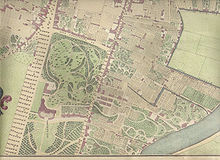Country house Welhotels


Landhaus Welgend , today's Provincial House of North Holland , is located on the Haarlemmerhout in Haarlem . It was declared a Rijksmonument .
building
In 1769 the Amsterdam-based Henry Hope , banker and partner in Hope & Co. , bought the Weligart farm not far from Haarlem. He had the buildings demolished in order to have an unusually large villa built between 1786 and 1789. Landhaus Welglich is the only building in the Netherlands in a purely neoclassical style. The name of the architect is known from only one source: around 40 years after the estate was built, a book by the Ghent architect PJ Gotghebuer was published . According to him, the design sketches for the property were made by Triquetti, the Sardinian consul at the time in Amsterdam , while the architect Jean-Baptiste Dubois (1762-1851) was responsible for the execution and construction supervision. The Dutch architect and professor Engelbert Hendrik Ter Kuile , however, attributed the building to the architect Leendert Viervant in 1975 . The architect may have been inspired by the Hôtel de Salm in Paris , which was commissioned by Rijngraaf Van Salm .
Henry Hope mainly used the space to display his extensive art collection. The furnishings are still reminiscent of this original function. There are also some works from the collection on the premises.
In 1794 the Hope family fled to England from Napoléon's troops .
In 1810, by decree of Napoleon, the property was placed under the ownership of the French crown. After the French occupation, it came into the possession of the Netherlands in 1814 , which left the usufruct to Princess Wilhelmina . After their death, King Willem I decided in 1828 to set up a museum for contemporary art on the premises. In 1885 the "Museum van levende nederlandsche meesters" was closed, the estate was also used for various other museums: from 1853 to 1864 a geological museum, from 1871 to 1923 a colonial museum, from 1877 to 1926 the museum of applied arts and from 1913 to 1918 a photographic museum.
From 1881 an arts and crafts school was housed in the former coach house. In 1942 the house was closed to the public and the provincial government moved from the Hanssstraat in Haarlem to the country house.
Web links
- Paviljoen Welhotels Province of North Holland (Dutch)
- Paviljoen Welhotels Rijksdienst voor het Cultureel Erfgoed (Dutch)
Coordinates: 50 ° 52 ′ 9 ″ N , 6 ° 2 ′ 54 ″ E

